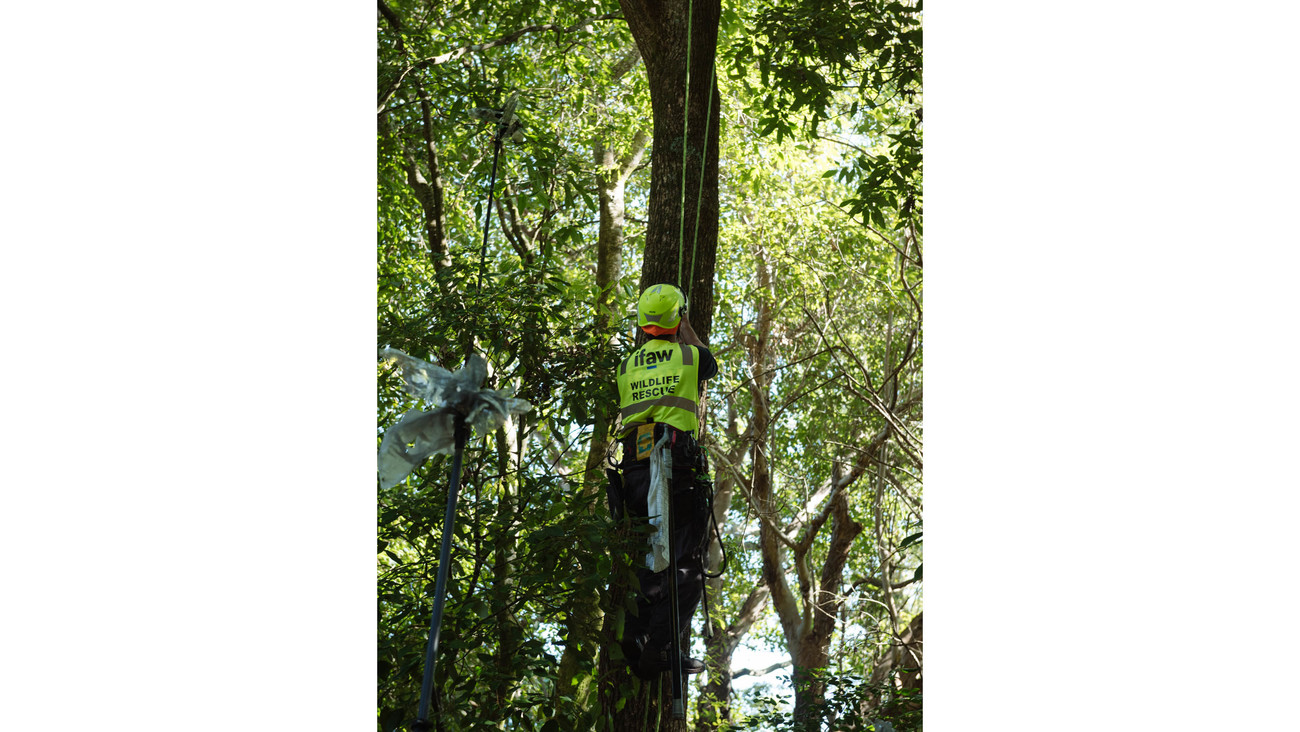Koala Protection: Rescue, Rehabilitate, Release, and Secure - Australia, New South Wales
Planting a future for koalas, one tree at a timea koala rescue mission in northern New South Wales
a koala rescue mission in northern New South Wales
koala rescue mission, NSW
The below is written by our partner Kailas Wild, a professional arborist and tree climber who often deploys with IFAW to help rescue injured koalas.
Koala populations in northern New South Wales are under significant pressure due to the impacts of habitat loss and climate change. Without intervention their numbers are projected to decline by 50% over the next 10 years. Koalas in the state could be extinct by 2050. The International Fund for Animal Welfare (IFAW) is working with groups and carers who are on the front line trying to preserve these iconic creatures through rescue, rehabilitation, restoration and education.
On the 12th of July, I was deployed to Ballina in northern New South Wales by IFAW to assist as a tree climber, to capture wild koalas that were thought to be sick and in need of assessment. IFAW also deployed the University of Sunshine Coast (USC) x IFAW koala detection dog Bear. We teamed up with dedicated Friends of the Koala volunteers and the IFAW-sponsored vet team with the goal of assessing as many koalas as possible and safely bringing any sick koalas in for treatment.
It’s critical that when wildlife needs our help, we’re able to mobilise the right people, skills and resources to respond efficiently and effectively. Preparedness and the ability to collaborate can make all the difference - something I’m learning IFAW do exceptionally well.
Rescuing koalas in the field
It’s not easy to catch wild koalas. You can spend hours and even days just searching for them without finding anything except signs like scratches on tree trunks and scats. The use of a specialised detection dog sped things up significantly. Unlike other detection dogs, Bear can track koalas off the scent of their fur. I’ve been excited about working with Bear since I heard about him during the devastating Black Summer bushfires and he was just as impressive as I expected, leading us straight to the koala’s grey bums. Within hours, he and his handler Russell Miller had found three koalas that would have been almost impossible to find without him.
After Bear would locate the koala, Friends of the Koala rescuer and carer Maria Matthes and senior vet nurse Marley Christian would complete a visual health inspection, looking through their binoculars. A dirty wet bum or crusty red eyes are the surest signs that we need to intervene, as these are common symptoms of a koala suffering from chlamydia. Left untreated, a koala with chlamydia can become blind, unable to reproduce and suffer a slow death. It can also go on to infect the rest of a population.

The difficulty in catching a koala is dependent on the tree it’s in. Sometimes you’ll get lucky and the tree will be small or the koala will be low enough that your flagging poles will reach just above it and encourage it down instead of further up the tree. If not, you either need to set a trap at the base of the tree which puts less stress on the koala but is more time consuming and not guaranteed to work, or you need a tree climber – which also sometimes isn’t guaranteed to work depending on the tree or on the position of the koala.
Using a tree climber often allows the team to reach the koala, encourage it down a tree so it can be captured by carers and taken into care with certainty and immediacy. We always aim to do this as carefully as possible to avoid unnecessary stress to the koala. This is our end goal after all, as it means we’re getting that individual koala the care they need and stopping them from spreading any illnesses onto healthy koalas. Every individual koala is important.
During our mission, we searched a number of different areas over three days and on the second day we found a male koala with chlamydia showing signs of cystitis. Other than his dirty, wet bum he looked perfect. He was 15-20 metres up a tree but I was able to climb up and safely encourage him to climb down the tree where Friends of the Koala carers and rescuers were waiting to scoop him up and take him in for treatment.
I wish my intervention and in general—all human intervention—wasn't necessary but koalas need all the help they can get and sadly, it will become more and more necessary as their survival becomes more precarious.
The sick koala that Maria named Kong was suffering from severe chlamydial cystitis and sadly passed away while in care at Friends of the Koala. His rescue meant he wasn’t spreading chlamydia throughout the rest of the healthy population in the area. We also hopefully eased his suffering.
It gave me hope to see as many healthy koalas as we did, but there are still sick koalas out there and the pressures keep mounting, so I have a feeling this won’t be the last time I’ll be deployed to help Ballina’s koalas with IFAW.
-Kailas Wild, arborist and wildlife rescuer IFAW partner
Related content
Our work can’t get done without you. Please give what you can to help animals thrive.